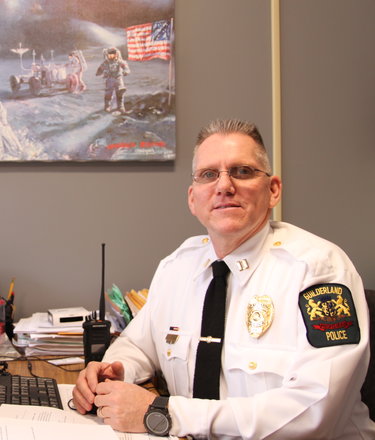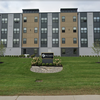Pilot program: SRO will be stationed, for free, at middle school till the end of the year
GUILDERLAND — The Guilderland School Board has agreed to station a police officer in the middle school for the rest of the school year as a pilot program. An officer is already stationed in the high school.
Guilderland Police Chief Daniel McNally had offered the second officer, for free, until the end of the year, but some members of the board had been reluctant.
Most board members first learned of McNally’s offer, made in August, at their Nov. 15 meeting where some expressed concerns that students of color may feel intimidated by an officer or felt that the money — if it became a permanent position funded by the district — could better be spent elsewhere.
Consequently, students were surveyed. Superintendent Marie Wiles reported that 694 high school students responded to the survey and 72.9 percent of them favored having a second officer at the middle school.
There were no significant differences based on students being male, female, or non-binary, she said, nor were there significant differences in response for students of color, whether Asian, Black, Hispanic or biracial, she reported. Students in all those categories were in favor at a rate of 70 percent or higher.
At Farnsworth Middle School, 699 students responded with 80.3 percent of them in favor of having a school resource officer at Farnsworth.
Responses showed “a little bit of a gender difference,” said Wiles, with 87 percent of females saying yes, along with 73 percent of males, and 74 percent of non-binary students. Race made no difference with 80 percent or more, in all categories, in favor.
Board member Gloria Towle-Hilt, referencing the fact that most of the students who spoke at the November meeting about their concerns with violence in the school and wanting another resource officer were white, said she was “very encouraged by the survey results.”
She did express concern that a video featuring the current school resource officer, Sean Ralston, showed him armed and wearing a uniform, which she said “looked intimidating.”
Board member Judy Slack said she found the video “showing students’ relationship with Sean very moving” and she wasn’t bothered by the uniform.
The neighboring school district in Voorheesville is taking a much more measured approach, said board President Seema Rivera. “We have this offer on the table,” she said, adding later, “It kind of puts you in a corner … You’re not going to say no … The next year, you’re going to pay for it.”
Once the pilot program has ended, the district would be responsible for paying $56,000 annually to cover the officer’s salary for the part of the year that school is open.
Chief’s view
Chief McNally stepped to the microphone to respond. “When I saw that the money was possibly the only reason we weren’t having one, I funded it …,” he said of a second SRO. “It wasn’t to put you on the spot. I don’t play those games. We’re talking about the safety of our kids.”
McNally went on, “I went to our town supervisor, which wasn’t easy to do, to get that funding because I’m taking a resource from the rest of the community and applying it to the school but I feel that strongly about it.”
McNally’s department has about 40 officers.
The SRO program in Guilderland was started in 1999 with one officer and was expanded in 2009 to include two officers — one stationed at the high school with another at the middle school. The district also has five elementary schools.
In 2012, because of recession-caused budget cuts, the program was cut back to one officer at the high school. That officer also tends to needs at the district’s other six schools.
This past March, the Guilderland School Board approved its first contract for a school resource officer.
In June, when The Enterprise wrote about the police department’s annual report, based on 2021 data, it noted the report showed just a handful each of child-abuse cases, sexual abuse cases, and juvenile arrests, but a stunning number of cases, over 700, for the school resource officer.
McNally explained then that these are not cases in the sense of investigations that may lead to arrests. Rather, he said, “It might be as simple as teaching in a health class, doing a lockdown drill, monitoring a student passing in the hallway.”
McNally said at the time that he had requested that, as the school district and police continue to do contracts for the school resource officer, the officer’s work be documented. “I wanted really specific numbers for what we were doing,” he said.
He also said then that he was “very much in favor” of adding another officer to the schools. “We are negotiating, we are talking about it as we are moving forward,” he said in June.
Asked about who has the upper hand — school administrators or the police officer — when there has been illegal activity at one of the Guilderland schools, McNally said of school administrators, “They try to manage and handle their incidents and situations in-house. And then, if it’s something that might be rising to the level of a crime, they start talking to the SRO in more detail.”
He also said, “We don’t act without the school being on board with what we’re doing.”
McNally emphasized, “The role of the SRO is to be an advocate to the students and staff … Frankly, if we’re going to make an arrest in the school of a student, we use one of our other officers to try to maintain that relationship and trust that we’re building with the students in the SRO.”
Board views
At the Dec. 6 school board meeting, board member Katie DiPierro, who works as a special-education teacher, said, “Our teachers rely on our SROs significantly.” Describing an incident she herself had experienced, DiPierro went on, “He was there to protect my role as a teacher.”
Board member Kim Blasiak said, “Our students, our community, and our staff have been saying they don’t feel safe.
Board member Nathan Sabourin said of installing another SRO, “This is becoming an easy answer to a very difficult and complex issue.”
He went on, “We have a security problem … these guys can’t do anything about it, not because they’re not capable but because we have a massive building-culture-level problem that we are not addressing.”
Board Vice President Kelly Person said, “Whether it actually fixes the problem, it’s going to make our students feel safer from what I understand, and that’s important.”
Board member Rebecca Butterfield said she was concerned about adding another program when Guilderland’s fund balance is the lowest in the Suburban Council. She also wanted to amend the district’s agreement with the police to require annual professional development.
McNally said he was not opposed to mandating education for the SROs nor was he opposed to having a board member or student participate in the selection process.
Wiles stressed that Guilderland schools are not alone in having “heightened issues of behavior and violence and fighting.” Nationwide, schools have faced problems as students, many of them isolated at home during the pandemic, have returned to classes.
“Every school district around our region, the state, and beyond is struggling with students who are exhibiting behaviors the likes of which we have not seen,” said Wiles.
She continued, “We are a microcosm of a bigger picture where there is a bigger problem and we are reflecting that. It’s not like we are an island of discontent or dysfunction. I’m not diminishing the challenges that we have but I don’t want our community to think that this is a Guilderland problem and everyone is just great because they are not.”
Ultimately, board member Blanca Gonzalez-Parker, who serves on the district’s safety committee and backed the second SRO all along, made the motion for the pilot program — and all nine board members voted in favor.


